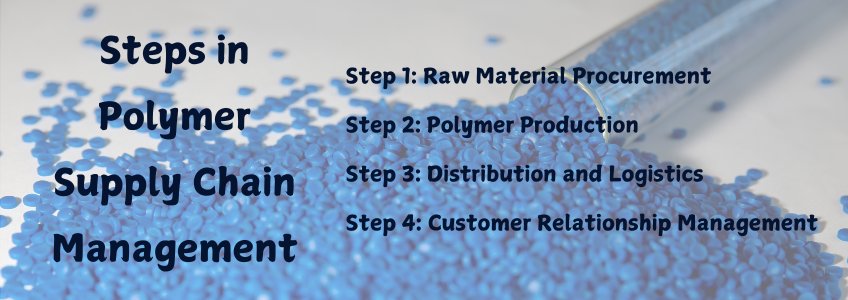
Introduction
The polymer industry is a cornerstone of modern manufacturing. It supplies the raw materials for a vast array of products, from plastics and textiles to automotive components and electronics.
Efficient supply chain management (SCM) is paramount in this industry because it ensures the timely delivery of high-quality polymers to meet the demands of diverse sectors.
This blog delves into the intricacies of polymer SCM, outlining the key steps, challenges, and strategies for success.
Steps Involved in Polymer Supply Chain Management

1. Raw Material Procurement
The first step of the SCM process begins with sourcing the essential raw materials, primarily crude oil and natural gas. These are considered to be the building blocks of polymers. It is important to build strategic partnerships with reliable suppliers to secure a consistent and cost-effective supply.
2. Polymer Production
In the next stage, the procured raw materials undergo complex chemical processes that transform them into various types of polymers, such as polyethylene, polyurethane, epoxy, silicone, etc.
3. Distribution and Logistics
Once products are manufactured, they are then transported to the distribution centers or directly to the customers. Efficient logistics networks, including warehousing, transportation, and inventory management, are essential to minimize costs and ensure timely delivery.
4. Customer Relationship Management
Building strong relationships with customers is vital in the polymer industry. Understanding customer needs, providing excellent service, and managing feedback are key components of successful SCM.
Hurdles in Polymer Supply Chain Management

- Fluctuating Prices of Raw Materials: Fluctuations in crude oil and natural gas prices can significantly impact the profitability of polymer manufacturers. Managing these risks through lean six sigma strategies or long-term contracts with suppliers is vital for smooth running of the polymer companies.
- Complexity of Supply Chains: Global supply chains for polymers are intricate, involving multiple suppliers, manufacturers, and distributors. Coordinating these operations and ensuring transparency can be challenging.
- Varying Market Demands: Market demand for polymers can vary significantly due to economic conditions, technological advancements, and consumer preferences. Forecasting demand accurately and adjusting production accordingly is crucial.
Overcoming the Hurdles

- Risk Management: Implementing robust risk management strategies using lean tools can help mitigate the impact of volatile raw material prices.
- Technological Advancements: Leveraging advanced technologies like algorithm-based forecasting and the Internet of Things (IoT) can improve supply chain visibility, optimize logistics, and enhance decision-making.
- Building Collaborative Partnerships: Fostering strong relationships with suppliers, customers, and logistics providers can create a more collaborative and resilient supply chain.
Advantages of Supply Chain Management in the Polymer Sector

- Improved Efficiency: Efficient supply chain management can streamline operations, reduce costs, and improve overall throughput.
- Enhanced Customer Satisfaction: By ensuring on-time delivery in full of high-quality products, SCM can enhance customer satisfaction and loyalty.
- Increased Profitability: Effective supply chain management also helps to increase profitability by optimizing resource utilization and minimizing waste.
- Risk Mitigation: A well-managed supply chain can help in identifying and mitigating potential risks, such as demand and supply management.
Conclusion
Therefore, effective supply chain management plays a critical role in the success of the polymer industry. By addressing the challenges involved in the polymer Supply Chain Management and implementing effective strategies for overcoming those, polymer manufacturers can create efficient, sustainable, and profitable supply chain strategies that meet the evolving needs of the market.
If you are interested in achieving similar success stories, write to us!
